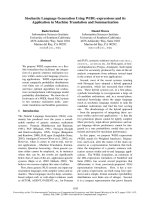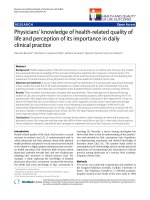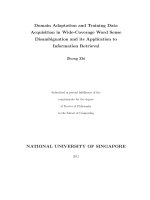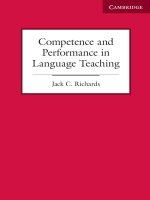Sense relations and its importance in language teaching
Bạn đang xem bản rút gọn của tài liệu. Xem và tải ngay bản đầy đủ của tài liệu tại đây (67.12 KB, 13 trang )
VIETNAM NATIONAL UNIVERSITY,
HANOI
UNIVERSITY OF LANGUAGES AND INTERNATIONAL
STUDIES
POST-GRADUATE STUDIES
------♣♣♣-------
Semantics assignment
Sense relations and its importance
in language teaching
Lecturer: Dr. Ha Cam Tam
Student: Nguyen Thi Bich Ngoc
Date of birth: 13/12/1985
Group: K17C
Hanoi, June – 2010
1. Introduction
From the "inward-looking" (internalist, cognitivist, metalistic, or
psychologistic) approach, which posist an extra level between word and
world: the level of metal representation, as presented in the following
digagram:
MIND/THOUGHT
LANGUAGE
WORLD
As can be seen from the diagram, meaning involves a set of three terms:
(a) A word = a linguistic term; (b) The referent = the thing referred to; (c)
The reference = the individual's concept of the thing referred to
As regards word meanings, two questions must be addressed: "How are
the meanings of words in a language inter-related?" and "How are the
meanings of words represented in the mind? In answering the first question,
we must look at diffrernt sense relations, i.e, the types of relationships
between words such as synonymy, antonymy, and entailment. In this
assignment, an analysis of different types of sense relations will be conducted,
data is collected from both English and Vietnamese language.
2. Sense relations between words
2.1. Homonyms
Homonyms are words identical in pronunciation and/or spelling but
different in meaning.
Examples: fast - fast;
here - hear;
tear (n) -tear (v)
Homophones
Homophone are words identical in pronunciation only.
Examples
Piece - peace;
bread - bred;
sight - site - cite;
Right - write - rite;
knight - night;
bare - bear.
Homographs
A homograph is a word with the same written form (spelling) as another word,
i.e., different in pronunciation and meaning. Homographs belong to the same
grammatical category or to different grammatical categories .
Example:
Tear - tear
Wind - wind
Full homonyms
Full homonyms are words identical in both pronunciation and spelling
Example: fast (v) - fast (adj)
Homographs and homophones can cause lexical ambiguity:
a.
She cannot bear children.
b. The nut is on the table.
c. The coach was here.
d. The priest married her sister.
Homonymy vs. polysemy
We need a number of criteria to distinguish homonyms and polysemy.
a. Semantic criterion
If there is a logical relationship btween the meanings of a word, this
word is a polysemantics word:
"head"
- part of the body
- person
- leader, etc.
On the contrary, if there is no logical relationship between the meanings
of a word, this word is actually not one word but one of the homophyms - full
homoyms.
b. Derivatinal criterion:
When one or more meanings of a "word" can form its/ their own
dervatives, we have homonyms:
Air - aircraft, airport, airline
Air (suggestive appearance)
c. Synonymy-based criterion:
When the synomyms of two or more words have nothig in common,
then the words are homonyms:
Bay - gulf
Bay - barking
d. Combinability criterion:
When tw or more meanins of a word have different combining ability or
different paradigms, we have homonyms:
Game - two games
Game (hunted animal) - no plurlal form
2.2. Synomyms
Synomyms are phontically and morphologically different words
belonging to same part of speech, posessing similar denotation but differing in
connotation, combinability etc.
'to help, to aid, to assist"
Usually, in suh a synomymousgroup, there is a synonymic dominant
which is the most general, newtral wods. The synomic dominant here is "to
help"
Basing on the similarity, syomyms are classified into: semantic
synomyms (synomyms differing in shades of meaning), e.g: nice, petty, goodloking, beautiful, handsome; stylistic synomyms (synonyms differing in
stylistic aspects), e.g., father, dad, daddy; semantico-stylistic synomyms
(synomyms differing in both shades of meaning and stylistic aspects), eg.g.
house - shack - slum - pad; phraseological synonyms (synomyms differing in
their collocations), e.g. do - make, say- speak, language- tongue; and terrtorial
synonyms (synoyms that belong to different countries/ regions), e.g. autumn fall.
2.3. Antonyms
Antonyms are words of opposite meaning and the same part of speech:
Example:
long-short
Love-hate
Selfish-unselfish
Usually, ajectives denoting qualities, verbs denoting actions or state and
abstract nouns have antonyms. Many words, especially concrete nouns have
no antonyms.
2.4. Hyponomy
Hyponomy is a relation of inclusion. For example: animal -dog. "dog"
is hyponym of "animal", "animal" is hypernym or superordinate of "dog".
Seen extensionally, the set of objects denoted by the superordinate term
includes the set of objects denoted by the hyponym—i.e. the set of animals
includes the set of dogs (the correct term—again from set theory—is that the
set of dogs is a sub-set of the set of animals. Looking at meanings
intensionally, however, might lead us to conclude that the meaning of ‘dog’ is
somehow richer and more complex than the meaning of ‘animal’, or even that
the meaning of ‘dog’ somehow includes the meaning of ‘animal’.
2.5. Meronymy
Meronymy describes a kind of part-whole relationship, and like
hyponomy it is a relation of inclusion. For example, ‘leaf’, ‘bark’ and ‘branch’
are meronyms of ‘tree’, because they are parts of a tree. There are parallels
between meronymy and hyponymy, although they are not the same—a poodle
is a type of dog and a cheetah is a kind of cat, but a leaf is not type of tree and
a clutch is not a type of car.
3. Sense relations between sentences
3.1. Entailment
Entaiment can be illustrated by the following two sentences with
sentence A entailing sentence B
A: He killed the banker.
B: the banker died.
In terms of truth value, the following relationships exist between these
two sentences if A is true, B is necessarily true. If A is false, B could be either
true or false. If B is false, A is necessarily false.
3.2. Presupposition
In the following pair of sentences, sentence A presupposes sentence B
A: My elder sister is a nurse.
B: I have an elder sister.
We can see that presupposition is similar to entailment in that when A is
true, B is true in both cases. However, there is an important difference
between them. Unlike entailment, presupposition is nor vulnerable to
negation. That is to say when A is false, B is still true.
3.3. Implication
Example: A: Few students can pass the examination.
B: Some students can pass the examination.
In a broader sense, both entailment and presupposition belong to the
relation of implication because a conclusion, that is sentence B can be drawn
from sentence A. However, their difference from implication is that the former
is vulnerable to conjunction. That is to say, if sentence A is put together with
the negative form of it entailed or presupposed sentence B, then the result will
be ridiculous.
For example: The banker is dead but he killed the banker.
I don’t have an elder sister but my elder sister is a nurse.
However, as implication is concerned, we can sfely say:
Few students can pass the examination or maybe none at all can.
Therefore, in the relation of implication when there is no contradiction
with the hypothesized proposition in the context both sentence B and A can be
true.
3. Application of sense relation in teaching reading skill
A majority of reading conprehension questions are based on the
understanding of words and sentences (IELTS, TOEFL, PET, FCE, CAE, etc.),
In order to answrer a question, students should first make sense of the
question, then locate the corresponding informatin in the original text and
finally choose the matching anser. The process of performing these taks is just
like indentifying the sense relations between the question original message
and the right answer. Therefore, when teaching reading skill, teacher should
highlight the importance and usefulness of sense relation in reading
comprehension. Following are example of the apllication of sense relation in
answering reading comprehension questions
3.1. Synonymy
Ex1. Brazil has becoe one of the developing world's great sucesses at reducing
population growth but more by accident than design.
Q: Accordngto the passage, Brazil has cut back its population than
design______.
A: by chance
In this example, the phrase "cut back" is synomymous with the word
"reduce" and the answer "by chance" is synomymuos with "by accident" .
Therefore, if students can understand the meaning of these words and phrases,
they will find no difficulties in answering the question.
3.2. Peraphrase and mutual entailment
Both synonym and paraphrase refer to the sameness or close similarity
of meaning but the former is between words while the latter proositions.
Paraphrase can also be regarded as a relation of mutual entailment.
Ex2. Faces, like fingerprint, are unique.
Q: By using the example of fingerprints, the author tells us
that________.
A: People differ from each other in facial features.
Here the proposition people differ from each other in facial features
paraphrases the proposition faces are unique. Therefor, it should be the right
answer.
3.3. Antonymy
Ex3. In the olddays, children were familiar with birth and death as part of life.
This is perhaps the first generation of American youngster who have never
been close by during the birth of a baby and have never experienced the death
of a family member.
Q: The elders of comtemporaru Americans_____
A: Usually witnessed the birth of death of a family member.
In this case, the expressions the elder and comtemporaty are antonyms
of the words children and old. Thus, we know the elders of the comtemporary
Americans refer to the children in the old days. At the same time, according to
the context witnessed the birth and death of a family member paraphrases
were familiar with birth and death as part of life.
3.4. Hyponymy
EX4. But we can easily tell the good guys from the bad guys because the two
types differ in appearance as well as in actions.
Q: According to the passage, it is possible for us to tell one tyoe of
person from another because_________.
A: people differ in their behavioural and physical characteristics.
As mentioned above, hyponymy betwee lexical items is a regular source
for entailment between sentences. Here actions and appearance are hyponyms
of behavioural and physical characteristics so the two types differ in
apprearance as well as in actions entails people differ in their behavioural and
physical characteristics.
3.5. Homonymy
Ex5. people will be alert and receptive if they are faced with information that
gets them to think about things they are interested in. And someone with
ahistory of doing more than less will go into old age more cognitively sound
than someone who has not had an active mind.
Q: People who are cognitively healthy are those_________.
A: Whose minds are alert and receptive.
The key word in this example is "sound" which is polysemous. Usually,
students are just familiar with its noun and verb meanings. However, it can
also be used as ajective and adverb, meaning "healthy", "dependable",
"thorough", etc. So if students can understand the different meanings of the
word, the answer will be very simple.
3.6. Presupposition
Ex 6. In my fridgeless Fifties childhood, I was fed well and healthy.
Q: The statement "In myfridgeless Fifties childhood, I was fed well and
healthily" suggests that_________.
A: there was no fridge in the author’s home in the 1950s.
This is a typical example of presupposition relation. Here the statement
in the original passage presupposes the answer.
3.7. Implication
Ex7. Too much exposure to X rays can cause skin burns, cancer or other
damage to the body.
Q: It is implied but not directly stated in the passage that ________
A: The patient can be exposed to a slight amount of radiation safely.
Here the implication of the original message is that some exposure to X
rays can not cause skin burns, cancer or other damage to the body, and the
answer just paraphrases it.
4. Conclusion
In reading skill, guessing the meaning of words in its context is an
effective way to understand the whole text and learn new word. However,
sometimes it is difficult or even impossible to guess the meaning of a word
only from the context. Therefore, other methods should be employed. Sense
relations play an important role in reading comprehension. It allows better
understanding of sentences and texts.
Moreover, when answering reading comprehesion question, sense
relations are even more important. In order to answer the questions,
praphrasing is an essential skill. In order to paraphrase sentence, it is
necessary to have good knowledge of senses relations. As can be seen, a
thought can be expressed in numerous sentences. It is necessary that teachers
highlight the importance and usefulness of sense relations to students.
Sense relations are also valuable in building up students’ vocabulary.
They help stimulate a systematic approach to facts concerning vocabulary.
With good knowledge of sense relatiopsn, students will effectively selecting,
grouping and analyzing new words. New words are better retained in students’
memory when compared and constrasted with previously learnt elements and
patterns.
Last but not least, students can also improve their reproductive skills
(speaking and writing) with knowledge of sense relations. Students can
express more ideas within a limited vocabulary, thus making them more
confident in contact with foreigners.
References
Austin, J.L. 1962. How to do Things with Words. Oxford: Oxford University
Press. Fishman, J. 1971. Advances in Sociology of Language I. The Hague:
Mouton.
Halliday, M.A.K. and Hasan, R. 1985. Language, Context and Text: Aspect of
Language In Socio-semantic Perspective. Victoria: Deakin University Press.
Sinclair, J.Mch and Coulthard, R.M. 1975. Towards Analysis of Discourse:
The English Used By Teachers and Pupils. Oxford: Oxford University Press.
Eggins, S. 1994. An Introduction to Systemic Functional Linguistics. London:
Pinter
Publishers.
Bloor, T. and Bloor, M. 1995. The Functional Analysis of English, A
Hallidayan Approach. London: Longmans.







